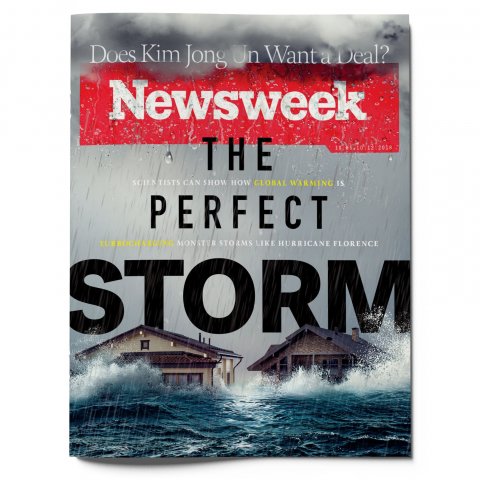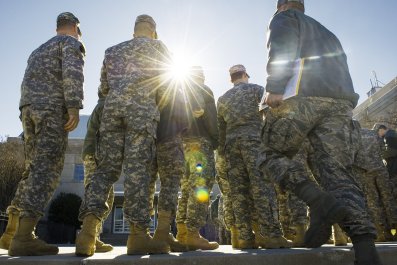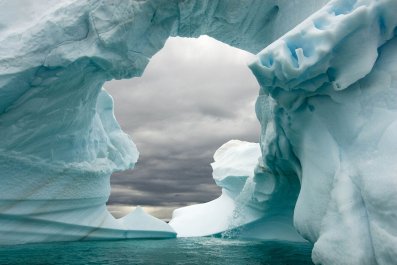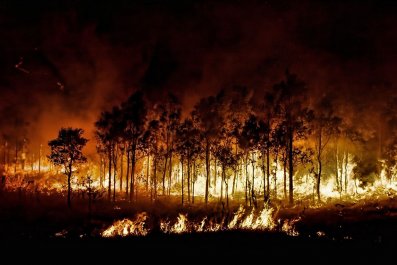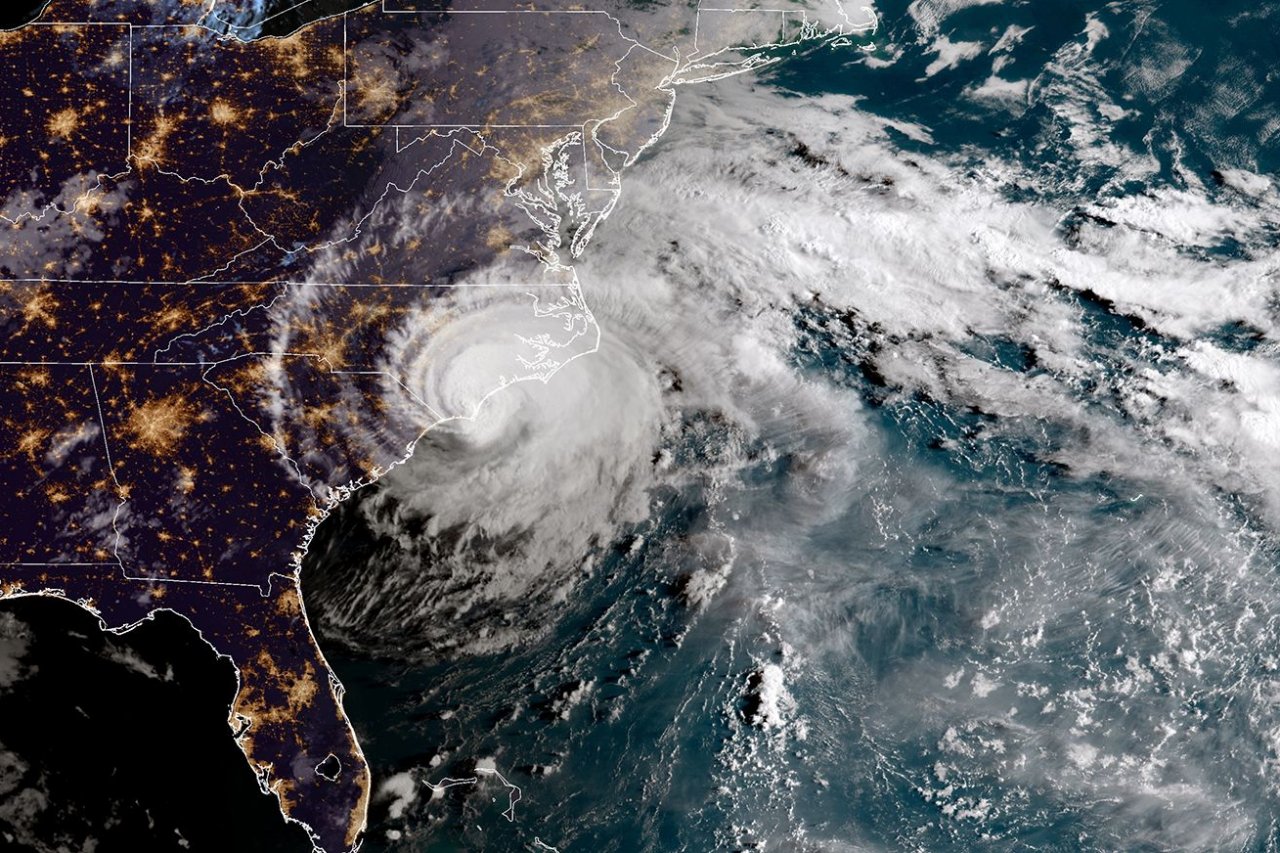
As Hurricane Florence approached the tiny port town of Wilmington, North Carolina, Steven Pfaff took small solace in the knowledge that there hadn't been much rainfall in August.
He hoped the absorbent ground would soak up whatever punishment Florence might inflict; when Hurricane Matthew arrived in 2016, the ground was already soggy, and the winds easily toppled trees in the loose earth.
Pfaff hunkered down in the offices of the National Weather Service (NWS), where he is a warning coordination meteorologist. There were shutters on the windows and a tornado shelter. But the 100-miles-per-hour wind was not the big problem. As Florence made landfall, it slowed to a crawl and dumped torrential rains. From his desk, he could hear the sounds of cracking wood as the trees gave way. The office smelled like a woodshop.
"The ground quickly saturated," he says. "That buffer was immediately wiped away. We went from rivers well below flood stage to now we're talking historic levels in some places. That's how intense this rain was."
Anthony Norris watched the downpour from nearby Elizabethtown. As deputy fire chief, he'd seen his share of bad weather, and Florence didn't impress him at first. "It seemed like the normal storm that comes through," he says. Then one road started to wash out after another, until the town was isolated—no one could come in or out.
The numbers released later by the NWS tell the story: more than 26 inches of rainfall in Wilmington, nearly 36 inches in Elizabethtown—about half a year's worth of precipitation. In a week, more than 8 trillion gallons of rain fell on North Carolina. The storm put about 10,000 people in shelters and left hundreds of thousands without power. At least 37 died in the storm.
Storms that drop that much rain are rare, but not as rare as they used to be. Even in just the past few weeks, several big storms have defied any notion of ordinary. As Florence struck North Carolina, a tropical disturbance dumped nearly as much rain on Texas as Florence did, albeit over a much larger area. And Typhoon Mangkhut struck Southeast Asia, killing at least 81 in the Philippines, many of them in landslides that buried homes and shelters.
This recent march of storms is part of a trend that has reignited partisan divides over climate change (see Page 29). Big storms with massively heavy rainfall are on the rise. Data from the National Climate Assessment show that between 1958 and 2012 rainfall from "heavy precipitation events" increased everywhere in the United States, but the eastern half of the nation has absorbed the brunt. Rainfall in the Northeast rose 71 percent, followed by the Midwest (37 percent) and the Southeast (27 percent).
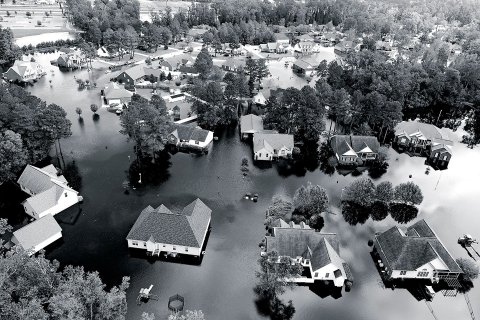
The frequency of more potent storms is growing, but the storms are also slowing down in speed, inundating the ground below. Last year, Hurricane Harvey dropped nearly 50 inches of rain on some parts of Houston, causing $125 billion in damage. (Hurricanes Irma and Maria arrived shortly thereafter, inflicting in excess of $100 billion in damage on Florida, Puerto Rico and the Caribbean.) Rain, not wind, was the main destructive force as the storm stalled over Texas for days. Florence followed the same script. A Category 5 hurricane when pushing across the Atlantic, it decelerated as it struck land. "Just after landfall, it was going 2 miles per hour—you could run faster than the forward speed," says Scott Weaver, director of the National Windstorm Impact Reduction Program in Gaithersburg, Maryland. The weather service downgraded it to a tropical cyclone in recognition of the milder-than-expected winds, but its slow pace gave the rains more time to wreak havoc.
What is Mother Nature trying to tell us? Probably the same thing climate scientists have been saying for years: that emissions of greenhouse gases, mainly carbon dioxide from burning fossil fuels, will cause an increase in the intensity of big, wet storms. Their "climate models"—vast computer programs used to predict what the climate is going to do in 50 or 100 years—tell them this. These models incorporate our knowledge of how storms behave and the surrounding environment, including how much greenhouse gas the atmosphere contains, how much polar ice sheets have melted, how much heat the oceans hold and so forth. These models are fabulously complex, but the basic physics is relatively straightforward: Warmer air holds more moisture, which spells more rain.
The models take all this data and spit out projections, in the same way weather models predict whether it will rain over the weekend, but they give their answers couched in statistics rather than direct statements of causality. We know that cigarette smoking increases the likelihood of getting lung cancer, but whether Uncle Harry would have gotten sick if he hadn't smoked two packs of cigarettes a day is impossible to know.
In the same way, scientists cannot declare that climate change created Florence. Probability, in the highly polarized politics of climate change, puts scientists into a rhetorical bind. It's hard to convince the public or politicians with projections about the long-term future couched as probabilities. For instance, the Intergovernmental Panel on Climate Change says average temperatures in the U.S. will rise anywhere from 3 degrees to 12 degrees Fahrenheit by 2100. We've heard this statement many times before.
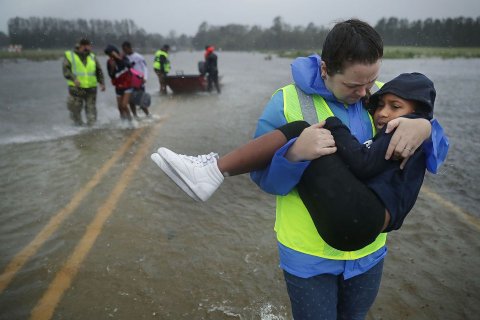
Kevin Reed was pondering this conundrum as Florence bore down on the East Coast. Reed, a climate scientist at Stony Brook University, got together with Michael Wehner of Lawrence Berkeley Laboratory and other colleagues and decided to find out how much climate change may be influencing the intensity of the approaching storm. It was a bit like trying to imagine what Uncle Harry might have been like if he'd never cracked that first pack of Marlboros.
What allowed Reed to even consider such an endeavor is the growing power of the computers that run these climate models. Until recently, climate models and weather models were two completely different beasts. Weather models could look a week or so into the future, but they would choke making predictions a year or 50 years out. Climate models had the opposite problem: They could see the big picture but didn't have the resolution to focus on specific events, such as a hurricane. In recent years, however, scientists have been able to bridge this gap. For his purposes, Reed took a climate model and tweaked it to make predictions about Florence.
On September 10, while Florence was still over the Atlantic Ocean heading toward North Carolina, Reed and his colleagues went to the U.S. National Oceanic and Atmospheric Administration (NOAA) and obtained reams of data describing exactly what Florence looked like at precisely 8 p.m. Eastern Daylight Time—thousands of readings of temperature, humidity, barometric pressure, wind velocity and so forth gathered by satellites, weather balloons, lighthouses and ships.
After plugging these bits of data—what computer geeks call "initial conditions"—into his climate model, Reed ran the program and got a prediction of how the storm would develop over the next seven days. It showed pretty much what the weather reports were saying: Florence would make landfall on the North Carolina coast near Elizabethtown and Wilmington, slow down and drop upward of 20 inches of rain.

Then they went back and ran the model again, but they used a different set of initial conditions—ones that simulated what the climate would have been like in preindustrial times, circa 1850, before William Blake's "dark Satanic mills" filled England with soot, kicking off the Industrial Revolution that has caused so much climate trouble since. That year, Millard Fillmore became president, the U.S. population stood at 23 million, and greenhouse gases in the atmosphere amounted to about 284 parts per million (they are now at 407 ppm).
This time, the model spit out a much different forecast. Although it showed the storm following pretty much the same path, rainfall estimates were far lighter—50 percent less in the worst-hit parts of North Carolina. In Elizabethtown, that implied 17.5 inches of rainfall rather than 35. That's still a lot of rain, but the damage would have been far less severe.
Reed isn't the first one to calculate how modern-day hurricanes would have developed without the greenhouse gases from industrial activity that we've emitted over the years. Scientists have done similar work for other tropical storms, with similar results. This is an emerging field in climate science called "attribution" because it is an effort to isolate specific effects of climate change. It borrows ideas from epidemiologists, who study risk factors associated with diseases—lead poisoning's impact on cognitive skills or the effects of air pollution on lung cancer. But climate attribution assigns risks to specific weather events.
Climate scientists started attribution studies after the 2003 European heat wave, which killed 35,000 people by some estimates, many of them elderly people confined to apartments with no air conditioning. Scientists found that climate change made the heat wave twice as likely to occur that year than in preindustrial times. Studies of Hurricane Harvey showed that precipitation in the Greater Houston area was elevated by nearly 40 percent because of climate change.

The experiment that the scientists conducted has limitations. For one thing, the study has not yet run the gantlet of "peer review" that all studies must survive to be accepted by the scientific community. Although scientists are confident of their results, they have not yet been able to quantify this confidence in rigorous ways. Working with models, rather than observations, is also inherently less precise. For instance, when Reed set the initial conditions for the model, there was a certain amount of "adjusting" that goes on to get the models to come out with a result that makes sense. Climate scientists are reluctant to talk publicly about this kind of thing, because climate skeptics have jumped on phrases like "tweaking the data" to cast doubt on legitimate climate research. And since the model starts after Florence was already a hurricane, it doesn't address the more fundamental question of whether the storm would have arisen in a world without global warming.
The Florence exercise is instructive, however. It suggests that climate change is already making the world vulnerable to flooding from excessive rain. The next step for Reed and his colleagues is to study how well their model matched up with the actual course of Florence and figure out how to improve it for future studies of this sort.
Some critics have pointed out that Reed's and other "attributive" climate models are misleading because they underestimate the contribution of climate change to extreme weather. Although they probably capture things like wind and rainfall with some accuracy, important climate factors such as storm surges and sea-level rise are beyond the ken of the models. As ice melts at the poles, sea levels have already risen between 4 and 8 inches in the past 100 years, and they are expected to rise between 1 and 4 feet by the end of the century. The eastern United States is particularly vulnerable in the coming decades. Due to the land subsidence—yes, the ground is literally sinking—the East Coast is likely to suffer an additional 4 to 9 inches of sea-level rise in the same period.
These developments promise to make a bad situation worse. As hurricanes move in from the Atlantic, they tend to push water up against the East Coast and into estuaries, causing extreme temporary rises in sea levels. During Florence, storm surges caused spikes in sea level of as much as 20 feet in some places. Superstorm Sandy in 2012 caused 11-foot storm surges in New York City, the largest ever recorded in the area, causing tens of billions of dollars in damage that the city is still addressing. Looking toward the end of the century, says Scientific American, protecting the entire East Coast from storm surges would require a sea wall 16 feet high from Maine to Miami. Building a border wall with Mexico would be easy by comparison.
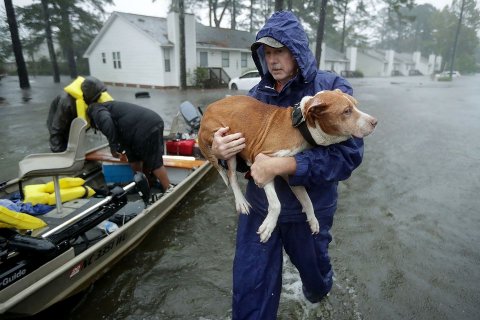
It doesn't help that developers continue to put condos along the coasts and build high-rises in Miami and New York and residential neighborhoods along estuaries. Development is a big reason why hurricane damage is so expensive. U.S. policies have "demonstrably caused a huge increase in hurricane damage," says Kerry Emanuel, a climate scientist at MIT. They "have strongly subsidized coastal development and population, leading more people to move to risky places and place infrastructure in harm's way." Unless policies are changed, he says, hurricane damage will continue "for the foreseeable future."
In the meantime, scientists are working to establish a firmer link between what theory (climate models) tells them about extreme weather and what they observe in the real world. We know for a fact that oceans are absorbing the lion's share of heat from climate change. Measurements show that oceans contain 90 percent of the heat that has accumulated between 1971 and 2010. According to the most recent Intergovernmental Panel on Climate Change report, most of that heat is in the top layer of water, which is rising about a 10th of a degree Celsius each decade. The energy in that top layer is a big driver of storms.
The more heat the oceans absorb, the more powerful these storms are going to get. "We see in models that it is likely that weak hurricanes will become less frequent while strong hurricanes will become more frequent," says Emanuel. Adam Sobel, a climate scientist at the Earth Institute at Columbia University, agrees that climate change is contributing to these storms. "We know there's climate change, so we expect to see certain changes in hurricanes," he says. "And we are starting to see hints of those happening already."
How that plays out in the real world over the coming decades is not clear. Weather is far more complex than any models scientists can devise, and natural variability creates a lot of noise that scientists have to sort through. The El Niño cycle, for instance, which sends warm water sloshing around the Pacific Ocean, has a huge effect on rainfall and weather patterns. The fate of the Amazon rainforest, the boreal forests of Canada and Siberia, the monsoons of West Africa and India, the Gulf Stream that carries warmth up the Atlantic to Europe—all of these natural features of the climate system are interrelated, and a change in any one of them affects the others and how future storms are going to play out.

Another problem is that weather records before the 1950s are unreliable and spotty—"too short and too flawed and not up to the task," says Emanuel. Much of what we know about weather back then comes from ship records, which were rife with inaccuracies and omissions. The lack of good historical data has hampered the ability of scientists to discern trends. For instance, Gabriel Vecchi and Thomas Knutson, climate scientists at the NOAA, argue that the hurricane count may have gone up in recent decades, rather than down, as most scientists believe.
The practice of attributing specific weather events to climate change also makes some scientists uneasy. "I think it is dangerous," says Emanuel. Better to continue to talk in the scientific language of probabilities. "Harvey's rain would have been possible 50 years ago," he says, "but far less likely."
The main benefit of the attribution studies may be their public relations value. Reed and Wehner certainly don't act the way scientists are supposed to act. Most scientists are loath to discuss the results of their research until it is published in a prestigious peer-reviewed journal. Publicity, in fact, can actually have a detrimental effect on an author's chance of getting published. Reed, by contrast, spent much of the week of the storm giving interviews to the media.
"Our view is that this was a way to engage the public," he says. "Climate change is often viewed as a distant threat. These attribution studies show that climate change is here and is having impacts now."
In their study of Florence, science was not the only objective of the exercise. The primary goal was to get the public's attention. By that standard, the research is a success.
